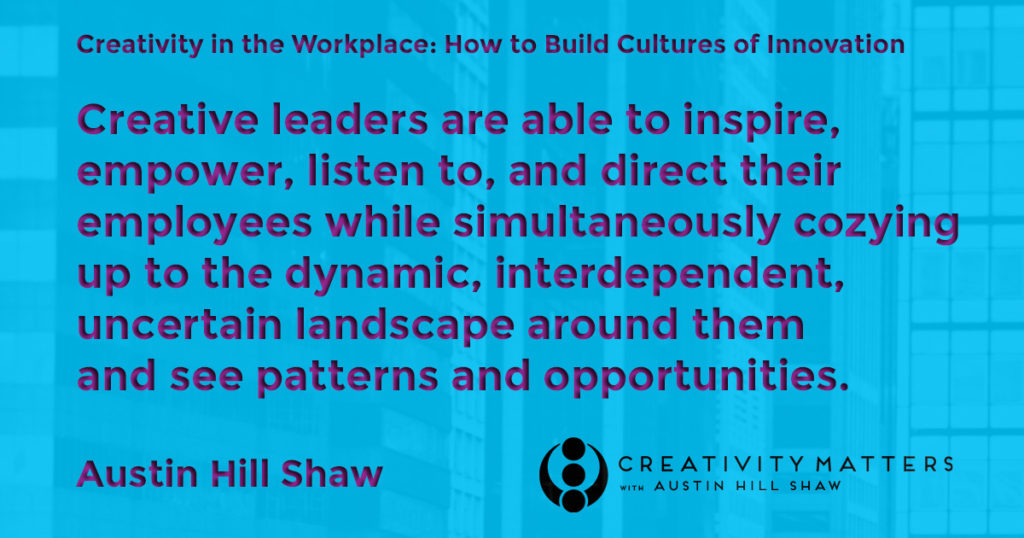Apply now for this year’s annual Healing and Self-Expression Retreat in the Sacred Valley and Machu Picchu, Peru
With their ability to be realistic about pressing challenges while simultaneously connecting with and inspiring their teams, creative leaders are essential.
What the single most important trait in leadership?
In order to kick this off, I want to go back to 2010. If you recall in 2010, we were just emerging from what was the heart of the economic crisis. With the implosion of the sub prime mortgage industry, markets all over the world were in turmoil.
During that time, IBM went out and poled over 1500 CEOs in different industries, asking them what the number one quality is for a leader to have.
Their answers? Creativity. Creativity was the most important trait to exhibit as a leader.

Why does creativity serve leaders in times of crises?
I find that fascinating that in the heart of this economic downturn that the consensus among CEOs across so many different industries was this idea that creativity, which, conventionally, can seem like such a “soft skill”, rose to the top.
The question is why?
We’ve already looked at some aspects of why that might be. We’ve looked at why creativity is essential to survival, because it allows us to shape shift and adjust to the ever-changing marketplace.
Creativity is essential for growth, because it allows us to grow not only in terms of the bottom line but also in terms of the culture and the the quality of the lives of the people that work at that organization.
We’ve also seen how creativity is the foundation of innovation, and that creativity and collaboration go hand in hand as both creativity and collaboration are part of our DNA.
When it comes to the connection between creativity and leadership, let’s turn to one of the most influential minds in the field of leadership, Jim Collins, who wrote a celebrated book, Good to Great. As the title suggests, Collins explored what makes some companies good and what actually make them truly great, including styles or levels of leadership.
What is level 5 leadership?
Collins identified five different levels of leadership, including and at the very top what he called a “Level 5 Leader”. “A Level 5 Executive” Collins wrote, “builds enduring greatness through a paradoxical blend of personal humility and professional will.”
What does that mean to have a paradoxical blend of personal humility and professional will?
Well, if you recall back when I was talking about innovation, I said that my definition of creativity is connecting with the world and affecting it in a meaningful way. If we look at what great leaders do, they connect with the world by having a sense of humility. Humility doesn’t necessarily mean meek, it means recognizing that we are all part of something much larger than ourselves, and beyond that, our very lives depend upon so many causes and conditions and things such as being supported by the natural world and the air and the water systems. All these things allow us to function on a daily basis.
Under such circumstances, to think that any one of us “goes it alone” is absolutely preposterous.
A Level 5 Leader recognizes, again, that they are part of the world, that they are children of the world, that they’ve received so much from the world, and when they go into their organizations, they recognize that, hey, it’s not my job necessarily to dictate what people should be doing, it’s my job, first and foremost, to listen, to be humble, to be curious, and, ultimate, to empower others to do their best.
That is the humility, that’s that willingness to connect.
But on the other hand, a leader is responsible for helping their team members make a difference, to create realistic goals, or even as Jim Collins would say “Big hairy audacious goals.” Right? Ways in which they inspire the people around them, that they bring forth their own sense of what is possible, even when the people around them can’t see what that is; the ability to say “Hey, we can do better than this.”
Again, however, a level 5 leaders push does not arise from a demanding, belittling sort of way. The humility is still there. Yet they’re allowing their people to make a difference by again such things as: “Okay, we’re here right now and we could be way further, and I think that we have the capacity to do that.”
This is professional will: Not only seeing the vision of where we could go, but also inspiring other to go along with it, primarily through the humility. And just being able to say, “Hey, I’m with you all. I’m your leader, but I am with you all. I care for you.” That is a benevolent leader. That is a powerful leader. That is a great leader.
How level 5 leadership intersects creativity
We can see already that there’s a connection between Collins’ definition of a Level 5 leader as one who “builds enduring greatness through a paradoxical blend of personal humility and professional will” and my definition of creativity as “connecting with the world and affecting it in a meaningful way.”

Per this last point, per the “meaningful” piece of my definition, great leaders are able to inspire others through their visions, through their missions, without being utopian about what the vision is.
Great leaders are very realistic in terms of what the problems might be, what the challenges are, but paradoxically they’re able to say, “But we can do it!”
They’re not airing on either side. They’re not saying, “Hey, it’s only challenges and problems,” nor they’re only saying, “Hey, we can just go here, and it’s going to be easy as pie.” Like great creators, great leaders are realist, they see both the current reality as well as the future possibilities. And, in order to carry things out, they draw upon the innate creativity and collaborative abilities of all the people around them in their organization.
That is essentially the links between creativity and leadership.
How to be a creative leader, even when you don’t feel like a leader at all.
Don’t be intimidated. You don’t have to be a CEO of and organization, you don’t have to be a “Level 5 Executive” to be a leader. I think the greatest way of leading is simply by leading by example, by YOU striving to connect with the world and affect it in a meaningful way in everything that you do.
If you walk your talk, when you’re being authentic and then true to yourself no matter where you are in an organization, what you do is contagious. When you are practicing humility and appreciating what people are doing around you but you’re also showing your ability to get things done, that is the quality of a natural leader.
When people start asking you questions, you can start to impart meaning in their lives by saying, “Hey, this is what I’m up to. I’m just connecting with the world and affecting it in a meaningful way.” It’s that simple!
It is truly that simple.

Your leadership is in your hands
Think of the ways in which you might start going out and owning your innate ability to lead through creativity. It matter not where you stand in an organization. and Perhaps, at first, you don’t even practice such leadership in the organization itself. Maybe it’s something that you do at home in the beginning: how can you be a great leader to your kids, to your spouse and your community?
Then in the organization, what are the things that you can do, what are the things that you’re saying, what are the things that need to be spoken out. Not again in a belittling sort of way or in a negative sort of way, but just saying realistically: “This is a problem here and I think we can do better. Right? I don’t feel particularly good about this thing, and I know that we can actually take it to a whole new level.” That is leadership on a very basic and powerful level, and that’s something that you can do, and that’s something that understanding creativity can empower you to do as well.
Austin Hill Shaw wants to bring creative leadership to your organization!
Austin Hill Shaw is a creativity expert who works with individuals who want to unlock their full creative potential and organizations that want to build cultures of innovation. He is the founder of Creativity Matters, author of The Shoreline of Wonder: On Being Creative, and inventor of The Creativity Quiz.
Apply now for this year’s annual Healing and Self-Expression Retreat in the Sacred Valley and Machu Picchu, Peru
Click here connect with Austin to bring more creativity and innovation into your organization.


